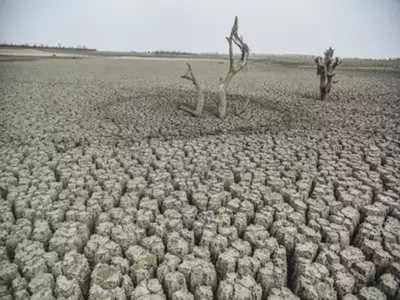- News
- Business News
- India Business News
- Severe droughts to impact 2-5% of India's GDP: UN report
Trending
This story is from June 18, 2021
Severe droughts to impact 2-5% of India's GDP: UN report
A special report on Drought 2021, released by the UN Office for Disaster Risk Reduction (UNDRR) on Thursday, estimated the “impact of severe droughts on India’s GDP to be about 2-5% per annum”, despite decreasing contribution of agriculture in the country’s expanding economy.

In recent major droughts in Tamil Nadu, a 20% reduction in the primary sector caused an overall 5% drop in industry and a 3% reduction in the service sector. (Representative image)
NEW DELHI: A special report on Drought 2021, released by the UN Office for Disaster Risk Reduction (UNDRR) on Thursday, estimated the “impact of severe droughts on India’s GDP to be about 2-5% per annum”, despite decreasing contribution of agriculture in the country’s expanding economy.
The study — Global Assessment Report (GAR) on Drought 2021 — has looked into rising water stress across the globe and resulting migration and desertification.The experts, commissioned by UNDRR, conducted case studies in the Deccan Plateau, comprising 43% of India’s landmass.
“The Deccan region sees the highest frequency (of more than 6%) of severe droughts in all of India,” the report has said. Its cascading impact continues over the next several years.
For instance, the report said, in recent major droughts in Tamil Nadu, a 20% reduction in the primary sector caused an overall 5% drop in industry and a 3% reduction in the service sector.
The study found “significant drought conditions” once in every three years in the Deccan Plateau leading to large scale migration and desertification.
A 2019 case study revealed “villages in Maharashtra and Karnataka’s districts were deserted as families left due to the acute water crisis; in one village in the Beed district of Maharashtra, which was abandoned with only 10-15 families remaining out of a population of more than 2,000,” the report said.
The GAR report has cited major droughts in India in the last 150 years: in 1876-1878, 1899-1900, 1918-1919, 1965-1967, 2000-2003 and 2015-2018. Severe droughts are occurring with increasing frequency in the Deccan, it found.
“Drought risk is complex and has broad systemic impacts on societies, economies and the environment – all of which underpin future sustainable development,” the report observed.
Its socio-economic impact and vulnerabilities are far more damaging to sustainable development. A 5% loss of GDP due to rising incidents of droughts is a big price to pay for a developing economy like India.
Globally, the report has estimated an annual loss of around $6.4 billion in the US due to drought and Euro 9 billion in Europe. In Australia, the study found its agricultural productivity fell by 18% during 2002-2010 due to drought-like conditions.
“Most of the world will be living with water stress in the next few years,” said Mizutori, cautioning policymakers to be better prepared with latest technology and early warning systems as increasing industrialisation and urbanisation would only lead to ‘demand outstripping supply’.
“Drought manifests over months, years, sometimes decades, and the results are felt just as long,” she added.
The study — Global Assessment Report (GAR) on Drought 2021 — has looked into rising water stress across the globe and resulting migration and desertification.The experts, commissioned by UNDRR, conducted case studies in the Deccan Plateau, comprising 43% of India’s landmass.
“The Deccan region sees the highest frequency (of more than 6%) of severe droughts in all of India,” the report has said. Its cascading impact continues over the next several years.
For instance, the report said, in recent major droughts in Tamil Nadu, a 20% reduction in the primary sector caused an overall 5% drop in industry and a 3% reduction in the service sector.
“Drought is on the verge of becoming the next pandemic and there is no vaccine to cure it. Drought has directly affected 1.5 billion people so far this century and this number will grow dramatically unless the world gets better at managing this risk,” said Mami Mizutori, the head of the UNDRR.
The study found “significant drought conditions” once in every three years in the Deccan Plateau leading to large scale migration and desertification.
A 2019 case study revealed “villages in Maharashtra and Karnataka’s districts were deserted as families left due to the acute water crisis; in one village in the Beed district of Maharashtra, which was abandoned with only 10-15 families remaining out of a population of more than 2,000,” the report said.
The GAR report has cited major droughts in India in the last 150 years: in 1876-1878, 1899-1900, 1918-1919, 1965-1967, 2000-2003 and 2015-2018. Severe droughts are occurring with increasing frequency in the Deccan, it found.
“Drought risk is complex and has broad systemic impacts on societies, economies and the environment – all of which underpin future sustainable development,” the report observed.
Its socio-economic impact and vulnerabilities are far more damaging to sustainable development. A 5% loss of GDP due to rising incidents of droughts is a big price to pay for a developing economy like India.
Globally, the report has estimated an annual loss of around $6.4 billion in the US due to drought and Euro 9 billion in Europe. In Australia, the study found its agricultural productivity fell by 18% during 2002-2010 due to drought-like conditions.
“Most of the world will be living with water stress in the next few years,” said Mizutori, cautioning policymakers to be better prepared with latest technology and early warning systems as increasing industrialisation and urbanisation would only lead to ‘demand outstripping supply’.
“Drought manifests over months, years, sometimes decades, and the results are felt just as long,” she added.
End of Article
FOLLOW US ON SOCIAL MEDIA















